Page 73 of 102

Downloaded from www.Manualslib.com manuals search engine Accelerator Linkage
Lubricate with engine oil every
15,000 .miles as follows:
1. V-8 Engine-lubricate cable pin
at the carburetor lever.
Hinges
The following points should be
checked and lubricated every 6
months or
7,500 miles, whichever
occurs first: hinges on all doors,
fuel filler door, trunk lid, door lock
striker and door jamb switches.
Hood Latches
Every 6 months or 7,500 miles
whichever occurs first, lubricate
hood latch assembly and hood
hinge assembly
as follows:
1. Wipe off any accumulation of
dirt or contamination on latch
parts.
2. Apply Lubriplate
or equivalent
to latch pilot bolts and latch
locking
plate,
3. Apply light engine oil to all
pivot points in release
mecha
nism, as well as primary and
secondary latch mechanisms.
4. Lubricate hood hinges.
5. Make hood hinge and latch
mechanism functional check to
5-12
asSUre the assembly is working
correctly.
Air Conditioning
Have your Chevrolet Dealer
check your Air Conditioning
sys
tem at some time during the winter
months to be sure there has been
no loss in cooling output. During
the summer, see your Chevrolet
Dealer immediately if you suspect
the system
is nof performing as it
should.
NOTE: Your car's air condition
ing system will not operate be
low ambient temperatures of 300P
( -1°C) regardless of control
position.
Page 74 of 102
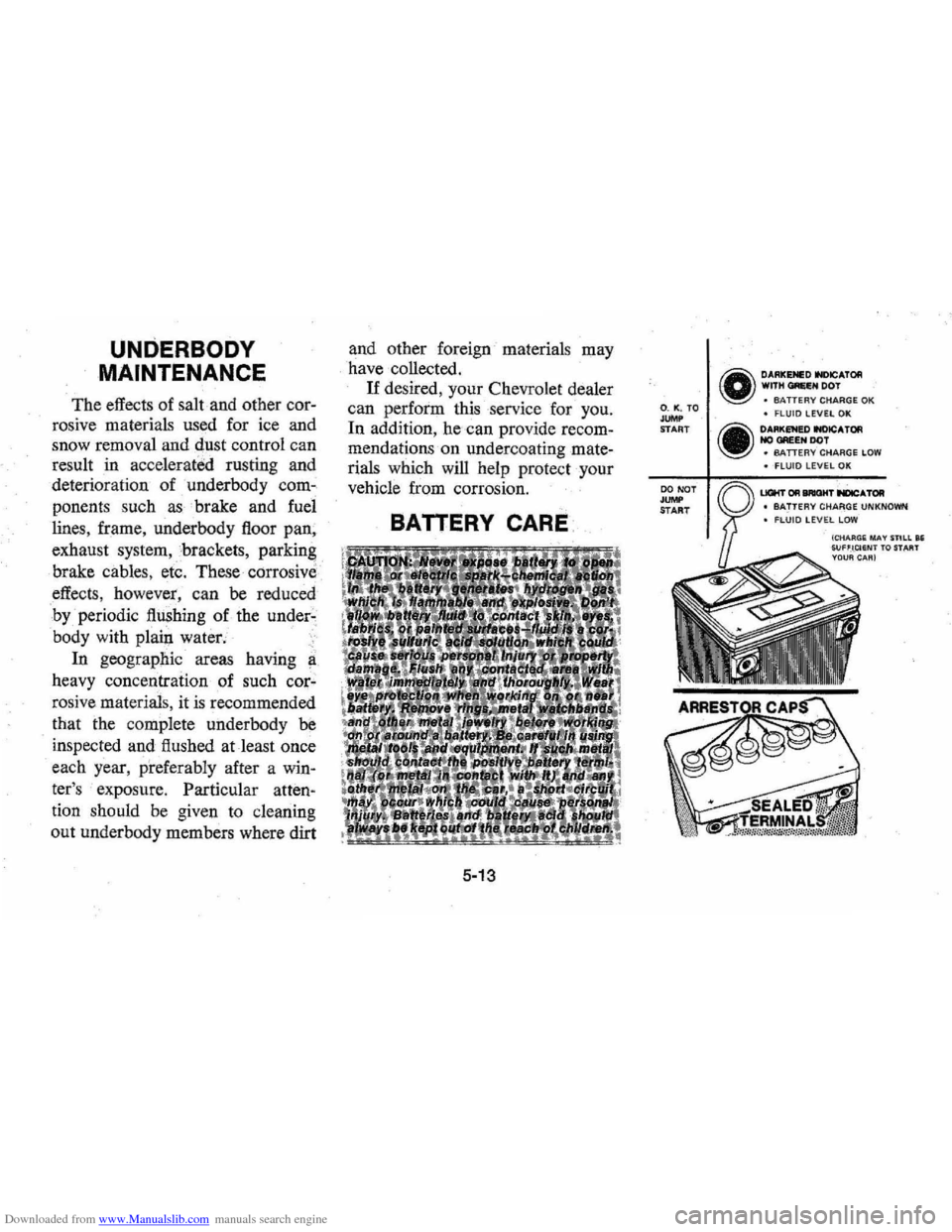
Downloaded from www.Manualslib.com manuals search engine UNDERBODY
MAINTENANCE
The effects of salt and other cor
rosive materials used for ice and
snow removal and
dust control can
result
in accelerated rusting and
deterioration of underbody
com~
ponents such as brake and fuel
lines, frame, underbody floor pan,
exhaust system, ·brackets, parking
brake cables, etc. These
corrosive
effects, however, can be reduced
by periodic flushing of the under- .
body with
plait) water;
In geographic areas having 11
heavy concentration of such COr
rosive materials , it is recommended
that the comple te underbody
be
inspected and flushed at least once
each year, preferably after a
win
ter's exposure. Particular atten
tion should be given to cleaning
out underbody members where dirt and
other foreign materials may
have collected.
If desired, your Chevrolet dealer
can perform this service for you.
In addition, he can provide recom
mendations on under coating mate
rials which will help protect your
vehicle from corrosion.
BA TIERY CARE.
5-13
O. K. TO JUMP START
DO NOT JUMP START
~ DARKENED .. DICATOA WITH GREtH DOT -_ - • BATTERY CHARGE OK • FLUID LEVEL OK
~ OARK9I!.D .. DICATOR NO GAEENDOT _ • BATTERY CHARGE LOW • flUID LEVEL OK
• BATTERY CHARGE UNKNOWN • FLUID LEVEL LOW
{CH ARG& MAV STILL IE SUFfICiENT TO START
Page 75 of 102
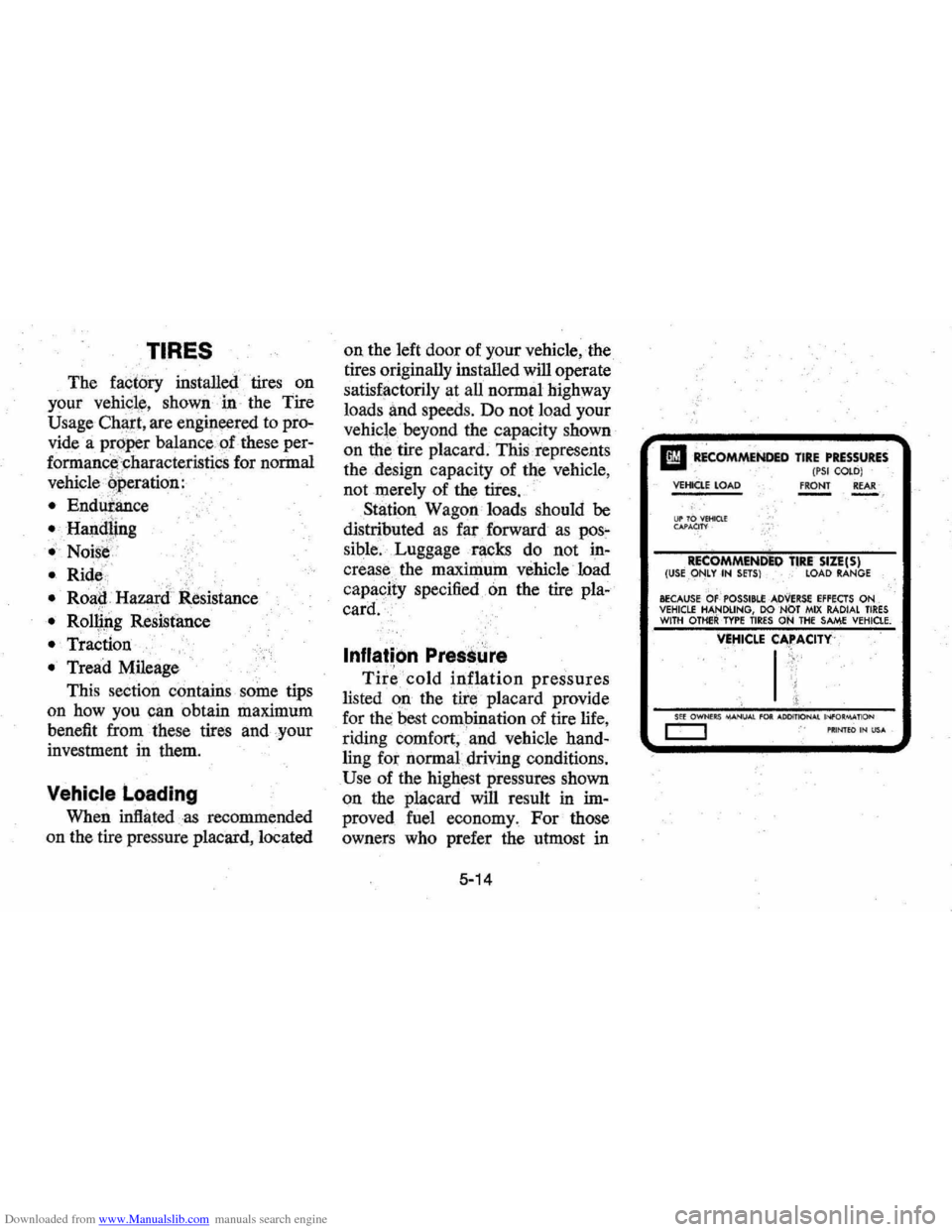
Downloaded from www.Manualslib.com manuals search engine TIRES
The factory installed tires on
your
vehicl ,e , shown in · the Tire
Usage Ch
vide a proper balance . of these
per
formance'characteristics
for normal
vehicle
~peration:
• Endu tiLnce '.~"
• Handling . ,'c'
• Noise·'
• Ride; .. /.
• Roaa Hazard ~esistance
• Rol~!1g Re~l$tiLnce
• Traction .'. .. ,
• Tread
Mileage .
This section contains some tips
on
how you can obtain maximum
benefit from these tires and your
investment in them.
Vehicle Loading
When inftiltedas recommended
on the tire pressure placard, located on
the left door
of your vehicle , the
tires originally installed will operate
satisfactorily at all normal highway
loads
and s peeds. Do not load your
vehicle beyond the capacity shown
on the tire placard . This represents
the design capacity of the vehicle ,
not merely of the tires .
Station Wagon loads
Should be
distributed as far forward as pos~
sihle . .Luggage racks do not in
crease
the maximum vehicle load
capaciiy specified. on the tire
pla
card.
Inflation Presslire
Tir~' cold inflation pressures
listed ' on the tire placard provide
for
the best combination of tire life,
riding ' comfort , . and vehicle
hand
ling for normal . driving conditions .
Use of the highest pressures shown
on the placard will result
in im
proved fuel economy. For those
owners
who prefer the utmost in
5-14
I
II REcOMMENDED TIRE PRESSURES - (PSI COlO) : YeHKlE LOAD fRONT REAR - ,
ur TO V1:HICI.! ~"m ;,..'
RECOMMENbiO TIRE SIZE(S) (USEQNLY IN SETS) LOAD RANGE .
BECAUSE, :O':'POSSI8LE ·A ,DYERSE EFFECTS ON VEHICLE HANDLING, DO 'NC)T MIX RADIAL TIRES WITH OTHER' TYPE TIRES oN THE SAME VEHICLE.
IIE!iICLE C"'~ACITY ~~,' ; ,',
j
, ~ SU OWNUS ~\) ..... fOft "'DOIflONAl l.'IfOR"'-"TION
c:::J I'I!INTEO IN USA _
Page 76 of 102
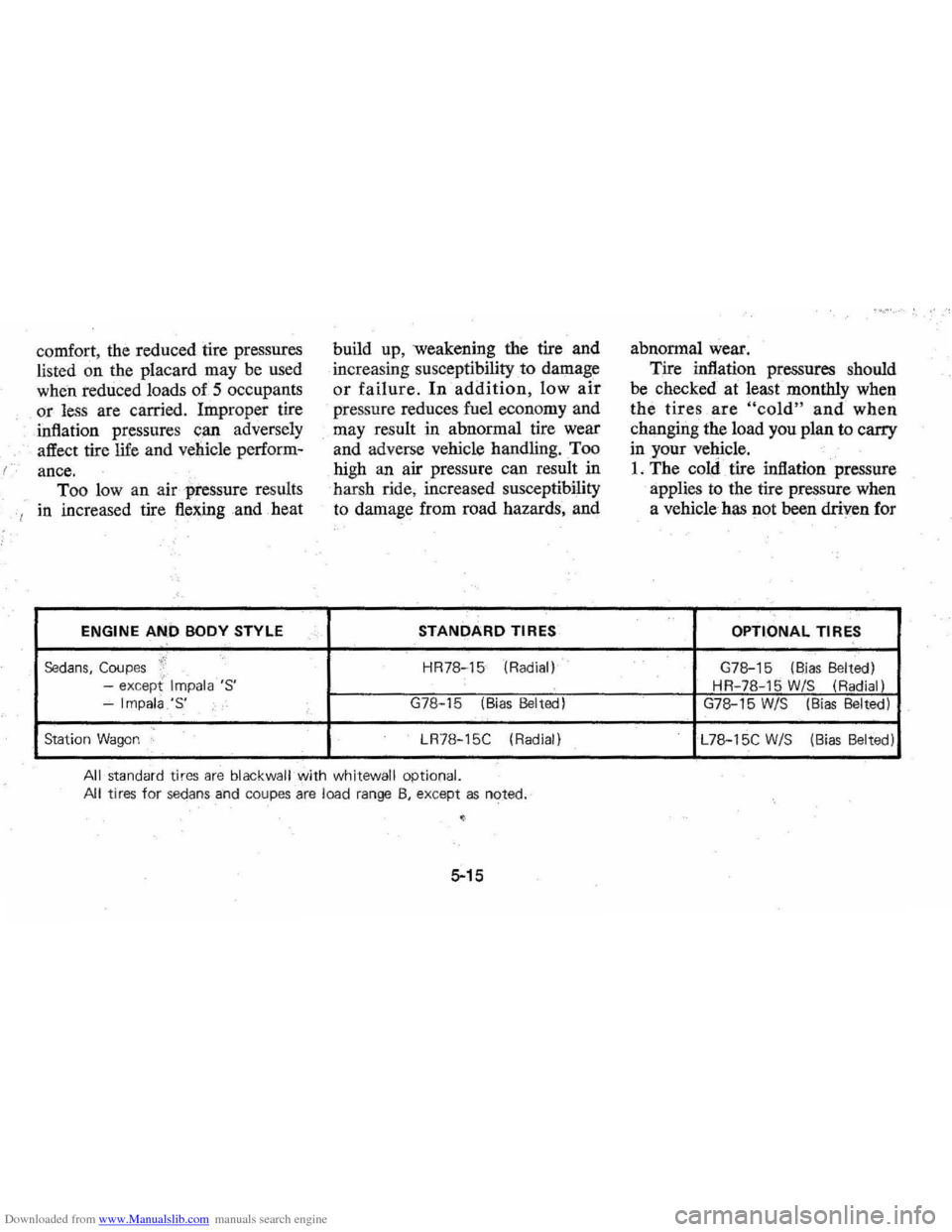
Downloaded from www.Manualslib.com manuals search engine co mfort, the reduced tire pressures
listed on the placard may
be used
when reduced loads of 5 occupants
or
less are carried. Improper tire
inflation pressures
c,an adversely
affect tire life and vehicle perform-
l' ance.
Too Iowan air 'pressure results
I in increased tire flellingand heat
ENGINE AN,D BODY STYLE
4' Sedans, Coupe s ;;' " -except Imp ala 'S '
~ Impala ,'S' ,
Station Wagon
,
.',
build up, weakening the tire and
increasing
sus ceptibility to damage
or failure. In addition, low air
pre ssure reduces fuel economy and
may result in abnormal tire wear
and adverse vehicle handling. Too
high an air pressure can re sult
in
har sh ride , increas ,ed su sceptibility
to dam a
ge fr om road hazards, and
STANDARD TIRES
HR78-15 (R adial)
G78-1 5 (Bias Belted)
LR7
8-1 5C (Radial)
All
sta ndard tires are blackwall With whi tewall optional.
All tires fo r sedan s a-nd co upes are load range 8, except as n ote d.
5-15
abnormal wear.
Tire inflation pressures should
be checked at least monthly when
the
tires , are "cold" and when
changing the load you plan
to carry
in your vehicle .
L The cold tire inflation pressure
applies
to the tire pressure when
a vehicle has not been driven for
OPTIONAL TIRES
G78-15 (Bias Belted)
HR-78-1 5
W/S (Ra dial)
G
78-15 W/S (Bias Belted)
L78-1 5C W/S (Bias Belted)
Page 77 of 102
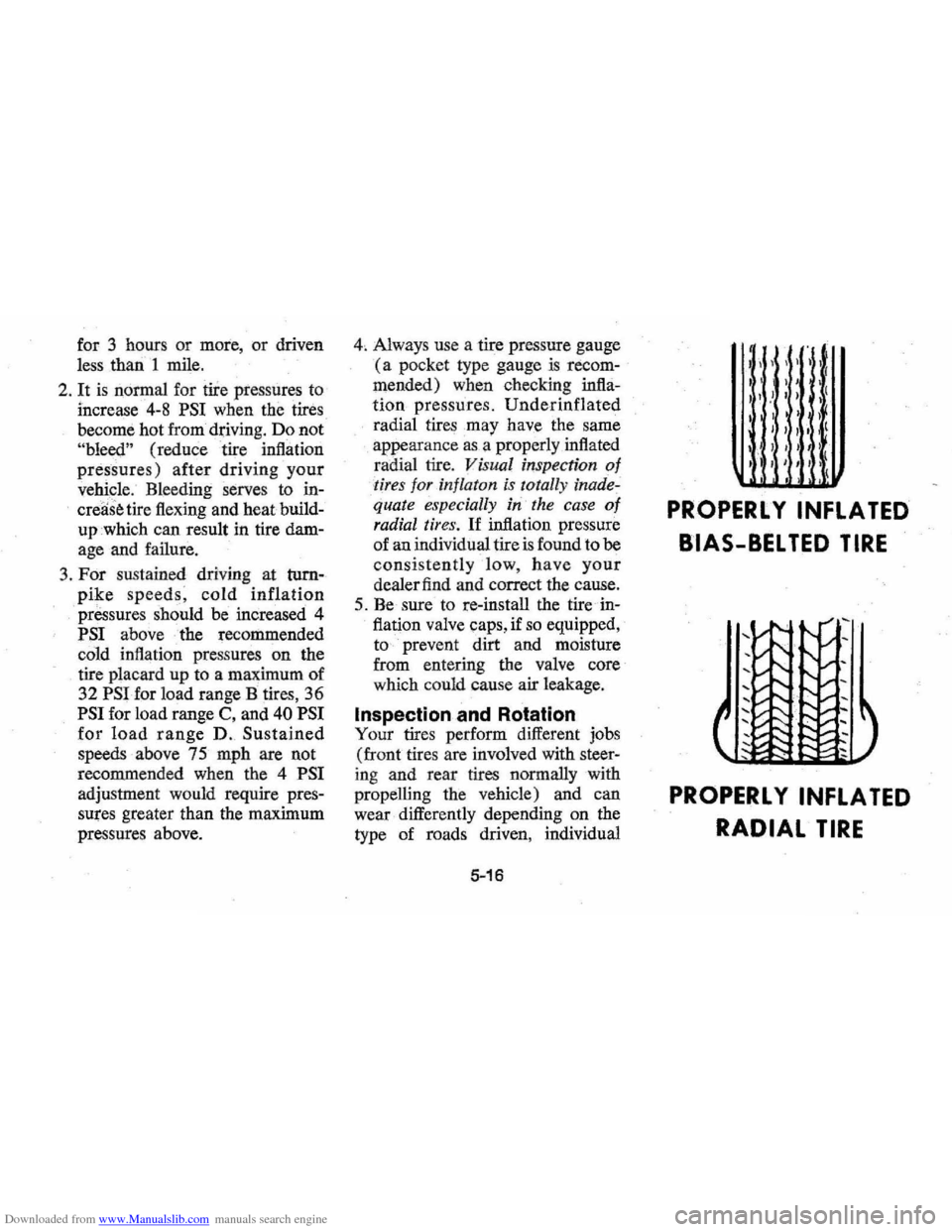
Downloaded from www.Manualslib.com manuals search engine for 3 hours or more, or driven
less than 1 mile.
2. It is normal for tiTe pressures to
increase 4-8 PSI when the tires
become hot from
driving. Do not
"bleed" (reduce tire inflation
pressures)
after driving your
vehicle. Bleeding serves
to in
crease tire flexing and heat build
up which can result in tire dam
age and failure.
3. For sustained driving
at turn
pike speeds; cold inflation
pressures should be increased 4
PSI above the recommended
cold inflation pressures on the
tire placard up
to a maximum of
32
PSI for load range B tires, 36
PSI for load range C, and 40 PSI
for load range D. Sustained
speeds above 75 mph are not
recommended when the 4
PSI
adjustment would require pres
sures greater than the maximum
pressures above.
4, Always use a tire pressure gauge
(a pocket type gauge is recom
mended) when checking infla
tion pressures. Underinflated
radial tires may have the same
appearance
as a properly inflated
radial tire.
Visual inspection of
-tires for in/laton is totally inade,
quate especially in the case 0/
radial tires. If inflation pressure
of an individual tire
is found to be
consistently low, have your
dealer find and correct the cause.
5. Be sure to re-install the tire in
flation valve caps, if
so equipped,
to prevent dirt and moisture
from entering the valve core
which could cause air leakage.
Inspection and Rotation
Your tires perform different jobs
(front tires are involved with steer
ing and rear tires normally with
propelling the vehicle) and can
wear differently depending on the
type of roads driven, individual
5-16
I
I '
,
)1, I
I I ( I , I , )' ,t
I ) I )
I , I I I I (
PROPERLY INFLATED
BIAS-BELTED TIRE
PROPERL Y INFLATED
RADIAL TIRE
Page 78 of 102

Downloaded from www.Manualslib.com manuals search engine LF RF LF
LR RR RR
.5 WHEEl ROTATION .. ··WHEEl ROTATION
RADIAL TIRES
BIAS PLY TIRE BIAS PLY TIRE .. WHEEl ROTATION .5 WHEEl ROTAtiON
BIAS-BELTED TIRES
driving habits, etc. To obtain maxi
mum. tire life you should inspect
a nd rotate your tires regularly.
Many car .and tire dealers will per
form a free tire inspection and
assist you in identifying uneven
or abnormal tire
wear which is
usually the result of incorrect infla
tion pressure , lack of regular rota
tion, improper wheel alignment,
out-of-balance ,
or poor driving
habits.
Bias and bias-belted tires should
be rotated
at least every 7,500
miles . Radial tires should be ro
tated at least at the first 7,500 miles
and then
at least at 15,000 mile in
tervals thereafter .or whenever. un
even tire wear is noticed.
Alignment and Balance
Proper front-end alignment ~i~i
mizes tire tread wear: To mlmmlze
tire wear, your front-end
susp~n
sion components should be m-
5-17
NOTE: It is recommended that the
brake s be
inspected for wear when
ever the tires are rotated.
spected regularly. See the
Main:e
nance Schedule folder for more lU
formation. Some ball-joints have
built-in wear indicators and some
movement in the joints
is normal.
Improper front -end alignment will
not cause vibration. Improper to e
alignment may cause your front.
tires to drag at an angle resulting in
excessive wear. Improper camber
alignment
may cause your front
tires to wear more on one side than
on the other arid can cau se the
vehicle to
"pull" to the left or right.
Proper tire balancing provides
the best riding comfort and helps
to minimiz e tire tread wear.
Out-of
balance tires can cause annoyin g
vehicle vibration and irregular tire
wear such
as cupping, flat spots,
etc.
Page 79 of 102
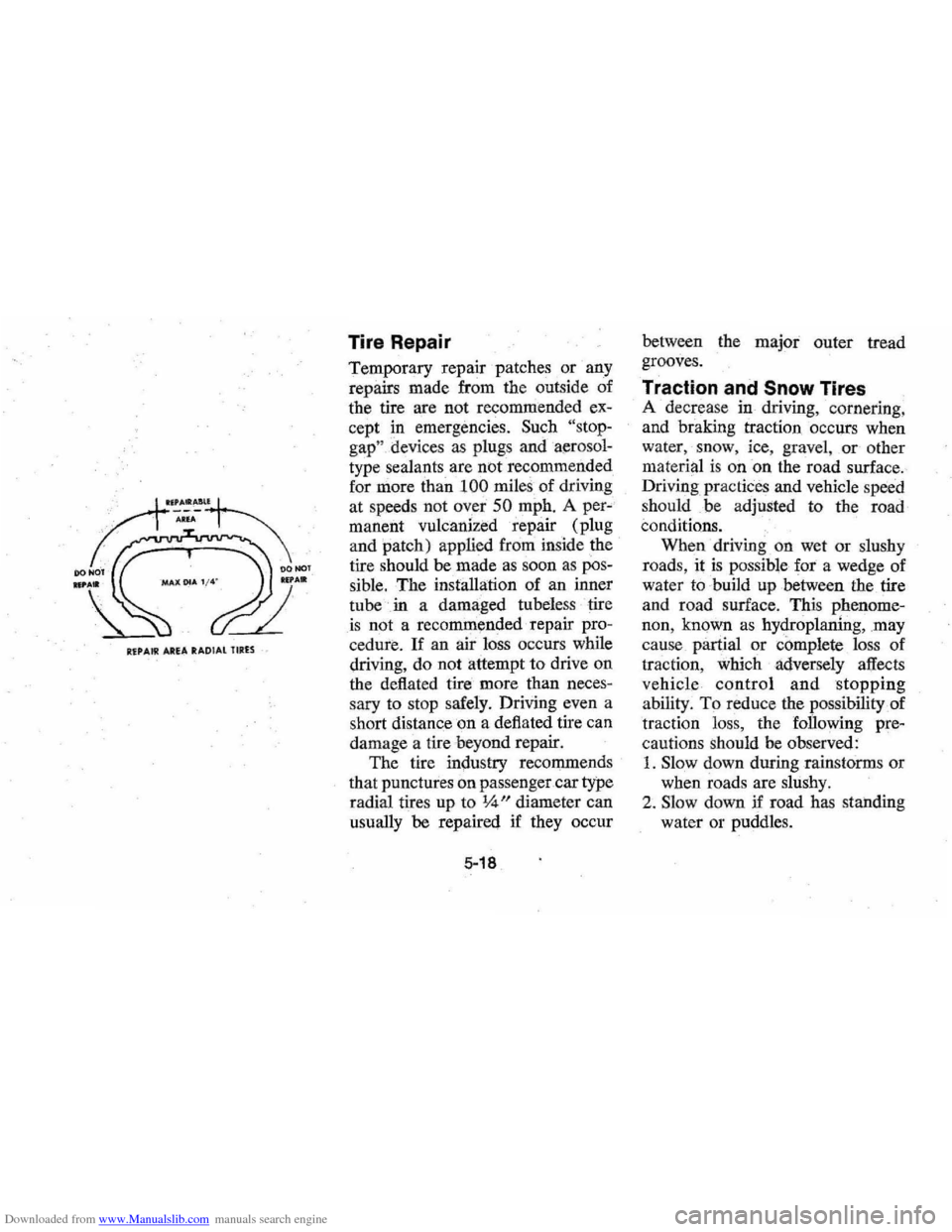
Downloaded from www.Manualslib.com manuals search engine Tire Repair
Temporary repair patches or any
repairs made from the outside of
the tire are not recommended ex
cept
in emergencies. Such "stop
gap" devices as plugs and aerosol
type sealants are not recommended
for more than
100 miles of driving
at speeds not over
50 mph. A per
manent
vulcanized repair (plug
and patch) applied from inside the
tire should be made
as soon as pos
sible. The installation of an inner
tube .
in a damaged tubeless tire
is not a recommended repair pro
cedure.
If an air loss occurs while
driving, do not attempt
to drive on
the deflated tire more than neces
sary to stop safely. Driving even a
short distance on a deflated tire can
damage a tire
-beyond repair.
The tire
in~ustry recommends
that punctures on passenger car type
radial tires up to
\4" diameter can
usually be repaired if they occur
5-18
between the major outer tread
grooves.
Traction and Snow Tires
A decrea se in driving, cornering,
and braking traction occurs when
water, snow , ice~ gravel, _ or other
material is on on the road surface.
Driving practices and vehicle speed
should be adjusted to the road
conditions.
When driving on wet or slushy
roads, it
is possible for a wedge of
water to build up between the tire
and road surface. This phenome
non, known
as hydroplaning, may
cause partial or complete loss of
traction, which adversely
affects
vehicle control and stopping
ability. To reduce the possibility of
traction loss, the
fan owing pre
cautions should be observed:
1. Slow down during rainstorms or
when roads are slushy.
2. Slow down if road has standing
water or puddles.
Page 80 of 102
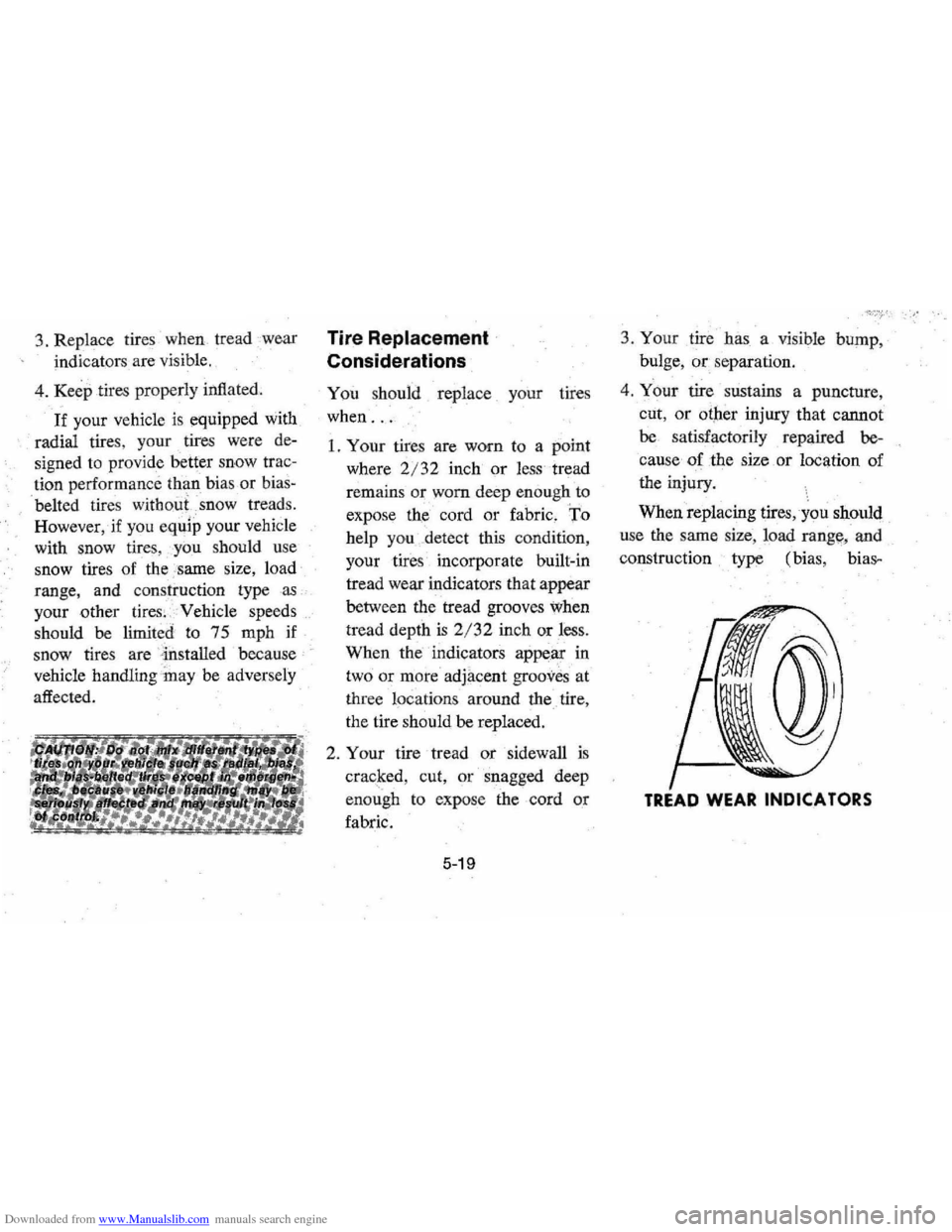
Downloaded from www.Manualslib.com manuals search engine 3. Replace tires when tread wear
indicators are visible.
4.
Keep tires properly inflated.
If your vehicle is equipped with
radial tires, your tires were de
signed
to p rov ide better snow tr ac
tion performance than bias or bias
. belt ed tires without snow treads.
However, if you equip your vehicle
with snow tires, you sh o uld use
snow tires of the
.'same size, loa d
range, and construction type as
your
other tires .. , Vehicle spe eds
should be limited to 75 mph if
snow tires are
'Ins tall ed bec ause
vehicle handling inay be adver
sely
affected.
Tire Replacement ·
Considerations
You should replace your tires
when
.. ,
1. Your tire s are worn to a point
where 2/32 inch
or less tread
remain s or worn deep enough to
expose the cord
or fabric. 'To
help you .. detect this condition,
your tir
es incorporate built-in
tread wear indicators
that appear
between the tread grooves
when
tread depth is 2/32 in ch or less.
When the indicators appear in
two
or m ore adjacent grooves at
thr ee l
ocation s around the tire,
the tire should be replaced.
2 .
Y our tire tread or sidewall is
crac~ed, cut, or snagged deep
enough to expose the cord
or
fabric.
5-19
3. Your tire has a visible bump, ·
bulge, or separati on.
4.
Your tire susta ins a puncture,
cut ,
or otrer injury that cannot
be satisfactorily repaired be
cau se
of the size . or location of
the injury.
When replacing tires, you should
u se the same size , load range, and
construction type (bias,
biag,.
TREAD WEAR INDICATORS